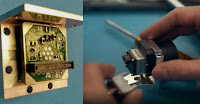NASA chose the Boson as it fits many of its stringent engineering requirements already, including the need for a small, lightweight, passively cooled infrared camera with 640x480 thermal resolution. The platform also lends itself well to customization and repackaging for surviving the rigors of space travel.
The Boson and package assembly developed by NASA has been fully tested and qualified at technology readiness level (TRL) 8 for operation in conditions including high vibration, shock, vacuum, high radiation, and temperature cycling from extreme cold to extreme heat. The modified Boson packaging could also serve as a potential option for use in the harshest of terrestrial conditions as well, including for aerospace and unmanned industrial machinery.
Inflatable Re-Entry Heat Shield Test.
The Boson will rest behind the heat shield, with the goal of monitoring the heat generated in the infrared spectrum as the shield descends back to Earth. An inflatable, lighter-weight heat shield could provide significant benefits for future missions, whether that’s returning to Earth or entering the atmosphere of neighboring celestial objects within the solar system. The modified Boson could also be used as part of imaging systems for future low-Earth orbit satellites and spacecraft.
The initial test is expected to commence imminently. Successful testing will increase the TRL to level 9 for the Boson and packing assembly, which is available for license from NASA Technology Transfer Program.
@flir @NASAsolutions @mepaxIntPR #Aerospace #Automation






















No comments:
Post a Comment